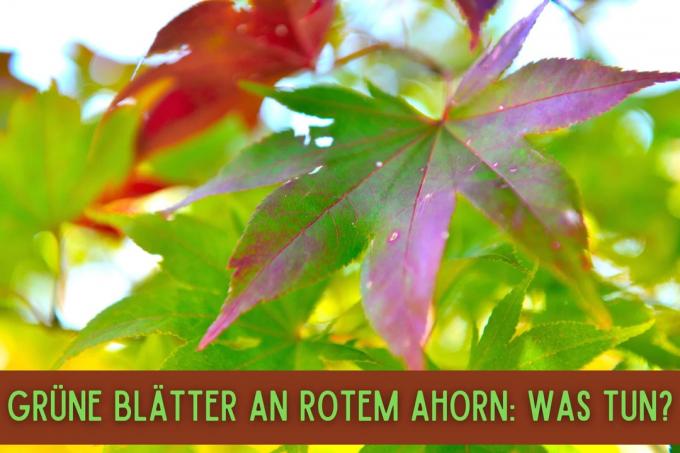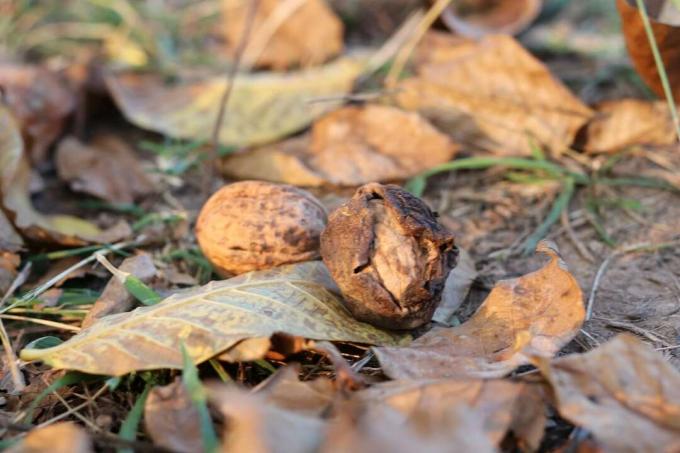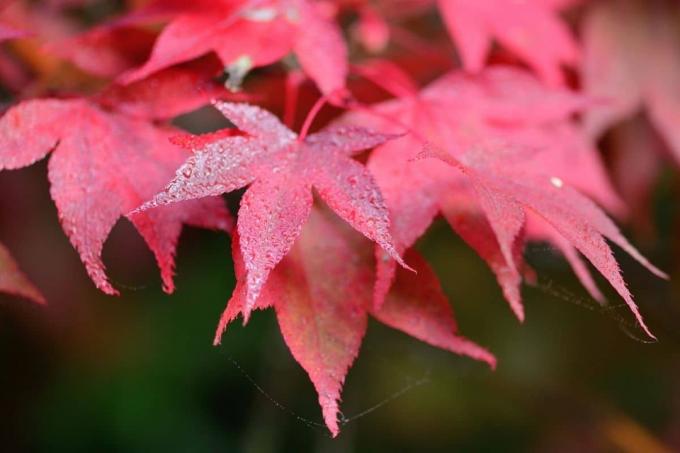
table of contents
- Green leaves are not uncommon
- Causes and remedies
- Unfavorable site conditions
- Too high pH
- Too nitrogenous fertilization
- frequently asked Questions
Japanese maple is known for its colorful foliage in different shades of red and its filigree leaf shapes. These pretty shrubs or small trees are real gems. But why do the red leaves on the maple sometimes turn green?
In a nutshell
- not all species have permanent red leaves
- some only red when budding or in autumn
- Leaves green for the rest of the year
- Green color normal for many varieties
- to look for other causes of greening in the site, soil or fertilization
Green leaves are not uncommon
Not every red Japanese maple shines in a beautiful red during the entire growth phase. There are species that only have a reddish color when budding in spring and / or autumn and are green the rest of the year. In most cases this is a natural process. With their red color, the leaves protect themselves from intense sunlight.
For this reason, they produce more of this red dye at the start of budding. If the leaves are larger, they usually no longer need protection and take on a green color. In contrast, Acer palmatum 'Atropurpureum' shows its splendid red color from spring to autumn. Despite everything, there are red Japanese maples that turn green for other reasons.

Note: The term Japanese maple often includes the actual Japanese maple (Acer japonicum) and the Japanese maple (Acer palmatum) with all their varieties.
Causes and remedies
If the leaves of the red Japanese maple turn green, there may also be other reasons due to errors or problems in care. We'll tell you the most common causes of “abnormal” greening and what you can do about it.
Unfavorable site conditions
Greened Japanese maple can be caused by an unfavorable location. A lack of or too little solar radiation can just as much as too much or If the sun is too intense, the red coloration is only weakly pronounced or does not appear completely and the leaves turn green. A change of location promises help.
- Red color depending on the variety and location
- most intensively at the optimal location
- Pay attention to the requirements of the individual species when purchasing
- bright and partially shaded location almost always correct
- unproblematic in spring and autumn locations in full sun
- Protect leaves from intense sunlight in summer
- otherwise burns may result
- Ideal locations near a body of water

Tip: Japanese maple has very special lighting requirements, which is why it can sometimes be advisable to cultivate it in a bucket. So it is always possible to put it in the right light and to avoid damage caused by the sun.
Too high pH
If the Japanese maple is in a soil with a high pH value, that can also be the cause of the greening of the leaves. Too high a pH value, i.e. in the basic range, can hinder the absorption of nutrients, even if they are present in sufficient quantities in the soil. The result: the red maple turns green.
- weakly acidic to neutral pH value between 4.5 and 7 optimal
- basic soil ensures green leaves
- calcareous substrates unsuitable
- Soil should be gritty-loamy or sandy-loamy
- also free of lime, well drained and well drained
Correct the pH value: Help
- for basic substrates: acidic rhododendron earth
- Mix too heavy soils with sand and coconut humus
- Make wet soils more permeable with 30-50 percent sand or gravel
- an additional 10 cm thick drainage layer on the bottom of the planting pit
- If possible, only water with rainwater

Tip: If necessary, the pH value of the soil can also be measured with the composted leaves of coniferous and walnut trees or oaks reduce. The current pH value of the soil can be easily tested with the help of a corresponding test from the hardware store or garden center.
Too nitrogenous fertilization
The foliage color of Japanese maples is significantly influenced by fertilization. If Japanese maple is fertilized with too much nitrogen, this leads to the fact that the leaves, especially red species, fade and turn green. In addition, fertilizers containing nitrogen make the plants more unstable and more susceptible to the cold. When fertilizing these plants - with the exception of potted plants - less is definitely more, otherwise there is a risk of greening.
- moderate to low fertilization recommended
- a gift compost often sufficient in spring
- Fertilize potted plants every three to four weeks
- with high quality complete fertilizer or special maple fertilizer
- Also here it is essential to pay attention to the dosage
- Do not fertilize at all from July
- The ripening of this year's shoots could affect autumn colors

Tip: The red is usually most beautiful and intense in the plants that are least fertilized, even if they actually belong to the Heavy consumers belong.
frequently asked Questions
The Japanese maples, which shine in different shades of red from spring to autumn especially Japanese maples (Acer palmatum), for example the varieties 'Shojo', 'Yugare', 'Beni' and ,Burgundy'. The Japanese fire maple (Acer japonicum) 'Atropurpureum' is also worth mentioning.
In principle, almost all varieties of Acer palmatum can also be kept in pots. However, dwarf varieties such as 'Shaina' with year-round deep red foliage, 'Skeeter's', are particularly suitable Broom ‘with red foliage in spring and autumn or the 'Red Pygmy' variety with dark red leaves that turn green in summer Leaves.
The most important thing is good drainage and a sufficiently large bucket. The bigger it is, the fewer problems there will be with care and wintering. If possible, it should be made of clay or terracotta. These materials release excess moisture to the outside so that the substrate is better ventilated. Since these plants often stand in the same tub for several years, a regular supply of water and nutrients must be ensured.

